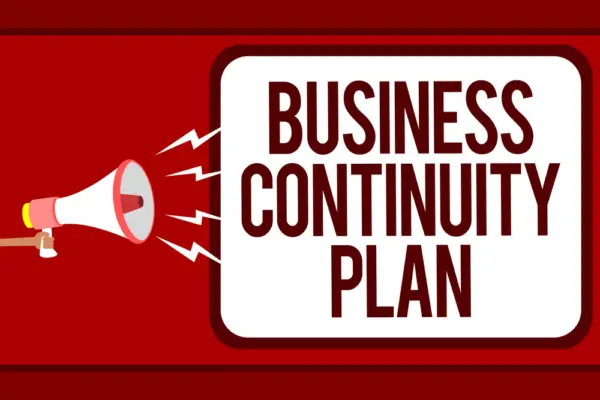A business continuity plan (BCP) is a critical document that outlines how an organization will continue to operate during and after an unexpected disruption.
It is a comprehensive strategy that includes detailed procedures and instructions to ensure that essential business functions can operate without disruption. However, the question remains, when is a business continuity plan invoked?
A business continuity plan is generally invoked when an unexpected disruption affects the organization’s ability to operate.
Various factors, including natural disasters, cyber-attacks, power outages, and other unforeseen events can cause the disruption.
The BCP is designed to provide a roadmap for the organization to follow during these disruptions, ensuring that essential business functions continue to operate and that the organization can quickly recover from the disruption.

The decision to invoke a business continuity plan is typically made by senior management in consultation with the BCP team. The team is responsible for implementing the plan and following all necessary procedures.
Once the decision is made to invoke the plan, the team takes over and ensures that essential business functions continue operating.
The BCP team is also responsible for monitoring the situation and adjusting the plan to ensure the organization can quickly recover from the disruption.
Understanding Business Continuity Planning
Defining Business Continuity Plan (BCP)
A Business Continuity Plan (BCP) is a proactive approach to ensure that a business can continue to operate in the event of a disruption.
It is a comprehensive plan that outlines how to respond to potential threats, such as natural disasters, cyber-attacks, or other disruptions that could impact the business’s operations.
The BCP is designed to protect personnel and assets, minimize disruptions, and ensure the business can operate with minimal downtime.
A BCP typically includes a risk assessment, a business impact analysis, and a plan for responding to disruptions.
It should also include a communication plan, a plan for how to work remotely, and a plan for recovering critical data and systems. The BCP should be reviewed and updated regularly to remain relevant and effective.
Importance of Business Continuity
Business continuity is critical for organizations of all sizes. Disruptions can significantly impact a business’s operations, reputation, and financial stability.
Without a BCP, a business may struggle to recover from a disruption, leading to lost revenue, customers, and even closure.
A BCP can help a business minimize the impact of a disruption and ensure that it can continue to operate.
It can also help to build resilience and reduce the risk of disruptions in the future. By identifying potential risks and developing a plan to respond to them, a business can be better prepared to handle disruptions and minimize the impact on its operations.
A BCP is essential for any business to ensure its continuity during a disruption. By defining potential risks and developing a plan to respond to them, a business can minimize the impact of a disruption and ensure that it can continue to operate with minimal downtime.
Components of a Business Continuity Plan
A Business Continuity Plan (BCP) is a critical document that outlines the strategies and procedures an organization must follow to ensure its critical business functions, processes, systems, and services can continue to operate during and after a disruptive event.
A BCP is invoked when a catastrophic event, such as a natural disaster, cyberattack, or power outage, disrupts normal business operations.
A BCP typically consists of three main components: Business Impact Analysis (BIA), Recovery Strategies, and Plan Development and Documentation.
Business Impact Analysis (BIA)
The Business Impact Analysis (BIA) is the first step in developing a BCP. It identifies the critical business functions and processes that must be maintained during a disruptive event, the resources required to support those functions, and the impact of a disruption on the organization’s operations, reputation, and financial stability.
The BIA also identifies each critical business function’s recovery time (RTO) and recovery point objective (RPO).
The RTO is the maximum acceptable downtime for a critical function, and the RPO is the maximum acceptable data loss.
Recovery Strategies
Recovery strategies are the procedures and processes that an organization must follow to restore its critical business functions and processes after a disruptive event.
The recovery strategies should include procedures for restoring hardware, software, and data, as well as procedures for relocating to an alternate site if necessary.
The recovery strategies should also include procedures for communicating with employees, customers, vendors, and other stakeholders during and after a disruptive event. The recovery strategies should be tested regularly to ensure they are effective.
Plan Development and Documentation
The final component of a BCP is plan development and documentation. This involves developing and documenting the procedures and processes required to implement the recovery strategies identified in the BIA.
The plan should include templates and checklists to ensure that all critical business functions are covered and that the recovery strategies are implemented in the correct order.
The plan should include contact information for all employees, vendors, and other stakeholders and procedures for activating the plan and notifying key personnel.
A BCP is a critical document that outlines the strategies and procedures an organization must follow to ensure its critical business functions, processes, systems, and services can continue to operate during and after a disruptive event.
The BCP consists of three main components: Business Impact Analysis (BIA), Recovery Strategies, and Plan Development and Documentation.
The BCP should be tested regularly to ensure its effectiveness in restoring critical business functions and processes after a disruptive event.
Activation of Business Continuity Plan
A Business Continuity Plan (BCP) is a documented collection of procedures and information that ensure the organization’s essential operations remain functional during a crisis, emergency, or disaster.
The BCP is activated when an event or situation threatens to disrupt the organization’s critical functions, processes, and infrastructure.
Criteria for Invocation
The decision to activate the BCP is based on specific criteria that trigger the invocation process. The criteria for invocation depend on the organization’s risk assessment, business impact analysis, and recovery time objectives.
The following are some common triggers for invoking a BCP:
- Loss of critical infrastructure.
- Loss of key personnel.
- Natural disasters.
- Cyber-attacks.
- Pandemics.
Communication Protocol
Effective communication is crucial during the activation of a BCP. The organization should have a communication protocol to ensure that all stakeholders are informed of the situation and the actions being taken.
The communication protocol should include the following:
- Notification procedures for stakeholders.
- Escalation procedures for critical events.
- Contact information for key personnel.
- Communication channels for updates and status reports.
Roles and Responsibilities
During the activation of a BCP, specific roles and responsibilities are assigned to ensure that the plan is executed efficiently.
The roles and responsibilities depend on the organization’s size, structure, and complexity.
The following are some common roles and responsibilities during the activation of a BCP:
- Incident Commander: Responsible for overall coordination and decision-making during the crisis.
- Emergency Response Team: Responsible for executing the BCP and ensuring the safety of personnel and assets.
- IT Recovery Team: Responsible for restoring critical IT systems and infrastructure.
- Communication Team: Responsible for communicating with stakeholders and providing updates on the situation.
Activating a BCP is a critical process that ensures the organization’s essential operations remain functional during a crisis, emergency, or disaster.
The decision to activate the plan is based on specific criteria, and effective communication and well-defined roles and responsibilities are crucial for a successful outcome.
Risk Assessment and Management
A business continuity plan (BCP) is a system of prevention and recovery from potential threats to a company.
To create an effective BCP, it is essential to conduct a thorough risk assessment and management process.
This section outlines the steps in identifying potential threats and evaluating risks to business operations.
Identifying Potential Threats
The first step in risk assessment is to identify potential threats that could disrupt business operations.
These threats can come from various sources, including natural disasters, cyberattacks, pandemics, supply chain disruptions, and internal business processes.
To identify potential threats, businesses should conduct a comprehensive risk assessment considering all possible scenarios.
This assessment should include an analysis of each threat’s likelihood and potential impact.
Evaluating Risks to Business Operations
Once potential threats have been identified, the next step is to evaluate the risks to business operations.
This involves analyzing the potential impact of each threat on the company’s operations, finances, and reputation.
Businesses should also consider the likelihood of each threat occurring and the resources required to mitigate its impact.
This evaluation process should be conducted with key stakeholders, including business leaders, IT professionals, and risk management experts.
Effective risk assessment and management are essential to creating a robust business continuity plan.
By identifying potential threats and evaluating risks to business operations, companies can develop a comprehensive plan that minimizes the impact of disruptions and ensures the continuity of critical business functions.

Disaster Recovery Planning
In a disaster, a Disaster Recovery Plan (DRP) is a crucial aspect of a Business Continuity Plan. A DRP is a documented process that outlines the procedures and policies to be followed in the event of a disaster.
The DRP ensures that critical IT infrastructure and data protection can be restored quickly and efficiently.
Disaster Recovery Plan (DRP)
A DRP is a comprehensive plan that outlines the steps to be taken in the event of a disaster. The plan should include detailed instructions for restoring IT infrastructure and data protection.
This includes data backup and recovery procedures, server restoration, email recovery, and other critical IT infrastructure.
The DRP should also include a Recovery Time Objective (RTO) and a Recovery Point Objective (RPO).
The RTO is the maximum amount of time that can elapse before critical IT infrastructure and data protection must be restored. The RPO is the point in time to which data must be restored in order to meet the RTO.
IT Infrastructure and Data Protection
IT infrastructure and data protection are critical elements of a DRP. The plan should include detailed instructions for restoring servers, data backup and recovery, and email recovery.
The plan should also include procedures for protecting data during a data breach.
To ensure that IT infrastructure and data protection can be restored as quickly and efficiently as possible, it is important to test the DRP regularly.
Regular testing ensures the plan is up-to-date and all procedures and policies are effective.
Disaster Recovery Planning is a critical aspect of a Business Continuity Plan.
A comprehensive DRP ensures that critical IT infrastructure and data protection can be restored quickly and efficiently.
The DRP should include detailed instructions for restoring IT infrastructure and data protection, a Recovery Time Objective (RTO) and a Recovery Point Objective (RPO), and procedures for protecting data during a data breach. Regular testing of the DRP ensures that the plan is up-to-date and effective.
Training and Testing the Plan
Employee Training and Awareness
One of the most important aspects of a Business Continuity Plan (BCP) is ensuring that employees are properly trained and aware of the plan.
This includes training on responding to a crisis situation and regular updates to the plan to ensure that it remains up-to-date and relevant.
Employee training should be conducted on a regular basis to ensure that everyone is familiar with the plan and knows how to respond in the event of an emergency.
This training should include information on crisis management, emergency response, and specific instructions on implementing the BCP.
Regular updates to the plan are also important to ensure that it remains relevant and effective.
This includes updating contact information for key personnel and making changes to the plan based on employee and stakeholder feedback.
Regular Testing and Exercises
In addition to employee training, regular testing and exercises are also crucial to the success of a BCP.
This includes testing the plan under various scenarios to ensure it is effective and can be implemented quickly and efficiently.
Testing should be conducted on a regular basis to ensure that the plan remains up-to-date and effective.
This includes tabletop exercises, which simulate a crisis situation and allow employees to practice their response, and full-scale exercises, which involve a more comprehensive plan testing.
Regular testing and exercises help identify any weaknesses in the plan and allow for updates and improvements.
This ensures that the plan remains effective and can be implemented quickly and efficiently in an emergency.
Employee training, regular testing, and exercises are essential to a successful BCP. By ensuring that employees are properly trained and aware of the plan and by regularly testing and updating the plan, organizations can be better prepared to respond to any crisis.
Maintaining and Updating the Plan
A Business Continuity Plan (BCP) is only effective if regularly reviewed and updated. Therefore, businesses should have a process to ensure that their BCP is always up-to-date and relevant.
This section will cover the review and improvement process and the schedule for regular updates.
Review and Improvement Process
Business Continuity Management (BCM) is an ongoing process, so the BCP plan should be reviewed and improved continuously.
The review process should examine the plan’s effectiveness in response to any incidents or disruptions that have occurred since the last review.
To ensure that the BCP plan is effective, it is recommended that businesses test their plan regularly.
Testing can be conducted through tabletop exercises, simulations, or full-scale testing. Testing provides an opportunity to identify plan gaps and make improvements.
Schedule for Regular Updates
ISO 22301 recommends that businesses review and update their BCP plan at least once a year. However, the frequency of updates may vary depending on the business’s needs and the industry in which it operates.
For example, a business that operates in a port may need to update its plan more frequently due to the high risk of disruptions.
It is also important to update the plan whenever business operations, processes, or systems change.
For example, if the business introduces a new product line, it may need to update its BCP plan to ensure it is prepared for potential disruptions.
Maintaining and updating a BCP plan is crucial to remain effective and relevant.
Regularly reviewing and updating a plan can ensure that businesses are always prepared in case of an incident or disruption.
Recovery and Restoration
When a disaster hits a business, the recovery and restoration phase is the most crucial part of the business continuity plan.
This phase focuses on restoring the business operations and returning to normalcy.
Implementing Recovery Strategies
During the recovery phase, businesses need to implement their recovery strategies. These strategies are designed to restore the services and operations disrupted by the disaster.
The recovery strategies should be prioritized based on the criticality of the services and operations.
One of the most important aspects of implementing recovery strategies is to ensure that the services and operations are restored within the Recovery Time Objective (RTO) and Recovery Point Objective (RPO) defined in the business continuity plan.
The RTO is the maximum time allowed for the recovery of services and operations, while the RPO is the maximum amount of data loss that is acceptable.
Business Resumption and Continuity
Business resumption and continuity are crucial during the recovery and restoration phase. The business continuity plan should ensure it can resume its operations quickly.
This includes ensuring that the necessary resources, such as equipment, personnel, and systems, are available to resume operations.
During the recovery and restoration, businesses should also focus on maintaining their reputation and customer service.
The disaster may have caused significant disruption to the business, and it is essential to communicate with customers and stakeholders to keep them informed about the status of the business.
Financial losses are also a significant concern during the recovery and restoration phase.
The business continuity plan should include measures to minimize the financial impact of the disaster. This may include insurance coverage, financial reserves, and contingency plans.
The recovery and restoration phase is a critical part of the business continuity plan. Businesses must implement recovery strategies, ensure business resumption and continuity, maintain their reputation and customer service, and minimize financial losses. By doing so, businesses can recover from the disaster and return to normalcy as quickly as possible.

Frequently Asked Questions
What events trigger the activation of a Business Continuity Plan?
A Business Continuity Plan (BCP) should be activated when an unexpected event could significantly disrupt normal business operations.
Such events may include natural disasters, cyber-attacks, pandemics, or any other situation that can have a significant impact on the organization’s ability to function.
At what stage in an emergency is a Business Continuity Plan typically put into action?
A BCP should be put into action as soon as possible after an emergency occurs. The earlier the plan is activated, the better the chances of minimizing the event’s impact on the organization.
The BCP should be activated as soon as the emergency is identified and the situation is assessed.
What are the primary components of a Business Continuity Plan?
A BCP should contain several key components, including a risk assessment, a business impact analysis, and a plan for response and recovery.
The risk assessment should identify potential threats and vulnerabilities to the organization, while the business impact analysis should identify critical business processes and functions and their dependencies.
The response and recovery plan should outline the steps to be taken to restore critical business functions and processes.
How does a Business Continuity Plan differ from a Disaster Recovery Plan?
A BCP is a comprehensive plan that outlines the steps to be taken to ensure the organization’s continued operation in the event of a significant disruption.
On the other hand, a Disaster Recovery Plan (DRP) is a subset of the BCP that specifically focuses on the recovery of IT systems and infrastructure.
What is the role of leadership in executing a Business Continuity Plan?
Leadership plays a critical role in the execution of a BCP. They are responsible for ensuring that the plan is up-to-date, regularly tested, and staff are trained in its implementation.
In an emergency, leadership is responsible for activating the plan and ensuring that it is executed effectively.
How can an organization assess the effectiveness of its Business Continuity Plan?
An organization can assess the effectiveness of its BCP by conducting regular tests and exercises.
These tests should be designed to simulate various disruptions and assess the organization’s ability to respond and recover. Regular assessments can identify weaknesses in the plan and provide an opportunity to make improvements.

Chris Ekai is a Risk Management expert with over 10 years of experience in the field. He has a Master’s(MSc) degree in Risk Management from University of Portsmouth and is a CPA and Finance professional. He currently works as a Content Manager at Risk Publishing, writing about Enterprise Risk Management, Business Continuity Management and Project Management.

